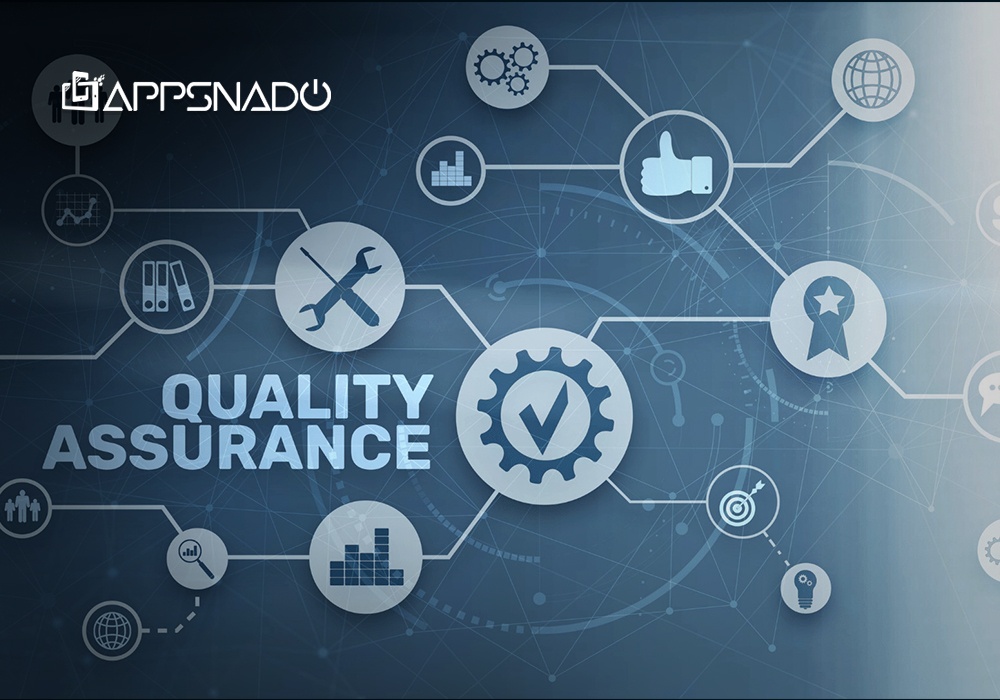In this read, you will find some amazing information regarding two essential procedures that are followed by professional technicians to make sure that each digital product is serving its purpose without any errors, bugs, or glitches. These procedures are known as quality assurance and quality control. From talking about the differences between quality assurance vs quality control to discussing their similarities, this article will cover it all. So, without wasting any time, let us get started with our topic.
What Is Quality Assurance? Understanding The Definition And Meaning

First things first, what is quality assurance? Well, by definition, quality assurance is known to be a part or subset of quality management. Its abbreviated form is known as QA, which is a collection of methods carried out throughout the product development process to guarantee a high-quality release.
For this reason, a company or business would hire professional software developers from many departments that are required to collaborate on planning, designing, and carrying out testing to ensure the quality of the final product. Another interesting fact about the QA methods is that they keep evolving depending on customer feedback and reviews regarding the production and working of a particular product.
How Does Quality Assurance (QA) Work?

People often get confused while understanding how the method or process of quality assurance works. Well, the answer is pretty simple, and we will discuss it in this section.
The first step in conducting the process of quality assurance methods is setting some policies that match the standards of a business for any technical procedure. These standards surround the procedures, materials, and completed goods that meet the relevant regulatory requirements.
In other words, quality assurance includes setting standards for each phase of product development and manufacture. This includes creating plans for achieving quality requirements, testing during production, and, last but not least, post-launch monitoring, which is necessary to guarantee that quality requirements are maintained.
You might be wondering what benefits or advantages this process provides to businesses or firms. By ensuring that the goods fulfill strict legal criteria, industrial sectors also provide other businesses with a competitive edge. The process of QA helps in maintaining a positive reputation as well as saving time and money through constant monitoring and upgrading of products.
Check Out These:
What Is Quality Control? Understanding The Definition And Meaning
Now that you have a detailed definition as well as an explanation of quality assurance, we will move forward and answer the question: What is quality control?
By definition, quality control is known as a subset of QA methods. The abbreviated form of quality control is QC. In this procedure, the development teams make sure the created product satisfies the organization’s requirements or standards for quality.
There is no harm in accepting the fact that users or consumers are considered valuable assets of any company or business. A bug or flaw in any of the product’s functions will automatically lead to a negative reputation for the company, which might take years to get as bad as it was before the mishap. However, quality control is the procedure that helps organizations fix items through a methodical QC approach to make sure they adhere to client expectations and business needs.
What Is The Difference Between Quality Control And Quality Quality Assurance?

A misconception among people is often found when they use the terms quality assurance and quality control for the same purpose. However, in reality, both procedures are different. In this section of the article, we will be discussing the difference between QA vs QC methods.
- Difference No. 1: Proactive Vs Reactive.
- Difference No. 2: Process Vs Product.
- Difference No. 3: Purpose.
- Difference No. 4: Moment Of Occurrence.
- Difference No. 5: Creation Vs Verification.
- Difference No. 6: System Vs Parts.
Check Out These:
- Difference No. 1: Proactive Vs Reactive
The first difference between quality assurance vs quality control lies in the nature of the terminologies and methodologies.
The nature of QA procedures is proactive. In other words, QA begins right at the beginning of a project. The development of policies based on standards, availability of raw materials, testing procedures, post-launch maintenance, and much more is part of the QA procedures that start from the beginning of the development until it ends. The main objective of the quality assurance method is to reduce the occurrence of defects and flaws from the beginning.
On the other hand, when we talk about quality control, it is known to be a reactive procedure in nature. This means that QC methodologies will be implemented once the product is developed. It is a helpful process when it comes to discovering and correcting flaws.
-
Difference No. 2: Process Vs Product
The second difference between quality control and quality assurance lies in the orientation of the procedures. On the one hand, we have QA, which is known as a process-oriented method whose goal is to prevent overall issues regarding the quality of the digital product.
On the other hand, we have QC, which is known as a product-oriented process that is focused on identifying quality issues once the product is manufactured in order to fix them.
-
Difference No. 3: Purpose
Next in line, we have the difference between the purpose of conducting the procedures of QA vs QC.
The purpose of the QA procedure is to prevent errors from occurring throughout the process of development. The developmental team makes sure to follow different testing procedures as well as precautionary measures to make sure that the number of errors is lessened during the phase of creation. On the other hand, QC has the purpose of identifying the remaining errors that might have been ignored before. In this regard, employees focus on fixing these errors once they are identified.
When we pay close attention to both procedures, it is easier to understand that the purpose of both methodologies is similar, which is to eliminate errors and bugs from a digital product, but the approach is different.
-
Difference No. 4: Moment Of Occurrence
The fourth difference between quality assurance vs quality control is that QA happens at every stage of the software development life cycle (SDLC). In simple words, you can imagine quality assurance as an ongoing process that takes place to establish, enforce, and guarantee digital quality.
On the other hand, we have quality control that only occurs when the digital product is developed and is ready to be tested.
Check Out: How a Charlotte Development Company Can Help You
-
Difference No. 5: Creation Vs Verification
The fifth difference between quality control and quality assurance lies behind the results of both procedures. On the one hand, we have QA methodologies whose results focus on the creation of a high-quality or good-quality digital product. It involves setting standards as well as assuring their application during the design phase, production phase, packaging, distribution, marketing, and sales.
Meanwhile, quality control procedures result in testing the products prior to mass distribution or after the release of the digital product on the market. QC methodologies ensure the security and efficacy of a product.
-
Difference No. 6: System Vs Parts
The sixth difference between quality control and quality assurance is that QA is implemented to control the entire system, maintain the high quality of the procedures, and secure the standards of the organization. On the other hand, QC methodologies are used to measure the parts of the system, for instance, the output.
What Are The Similarities Between Quality Assurance And Quality Control?

“Now that we have studied the differences between quality assurance vs quality control, we will now discuss the similarities between both procedures.”
- Similarity No. 1: Production Of High-Quality Products.
- Similarity No. 2: Usage Of Policies And Procedures.
- Similarity No. 3: Investment Of Cost And Time.
- Similarity No. 4: Reduction Of Cost By Elimination Of Errors.
-
Similarity No. 1: Production Of High-Quality Products
The first similarity that is worth noting between quality assurance and quality control is that both of these procedures focus on producing and delivering high-end quality products. Since their goal is to eliminate a digital product from all kinds of bugs and errors, QA aids the organization in developing a strategy for its approach to digital quality, and QC makes sure the final product fulfills standards.
-
Similarity No. 2: Usage Of Policies And Procedures
The second similarity between quality control and quality assurance is that both of these methodologies require testers, developers, and other employees to follow certain policies, standards, and set procedures to maintain the reputation of the organization.
In this regard, both methods adhere to the organization’s requirements for ensuring good quality that require the employees to record and organize the data regarding the detection of errors and their appropriate solutions and outcomes.
-
Similarity No. 3: Investment Of Cost And Time
Next in line, we have the similarity of investing money and time in QA and QC procedures. Up until now, one thing is clear: in order to make consumers happy and satisfied, companies and businesses have to launch good-quality products that will ensure effective and efficient working benefits.
In this regard, both quality assurance and quality control procedures require a considerable amount of money as well as time invested in the application of testing procedures. Once a company invests money and time in these QA and QC practices, they can stay stress-free in the long run regarding their digital product not working properly or showing errors.
-
Similarity No. 4: Reduction Of Cost By Elimination Of Errors
Last but not least, we have the similarity of mitigating costs and problems that an organization might have to face in the future if they do not spend time on their QA and QC procedures. In this regard, both quality assurance and quality control enable companies and businesses to save themselves from major losses like lack of user retention, lack of customer satisfaction, sales generation, and a lot more if they do not detect the errors and fix them before launching the product.
On the other hand, if a firm or business does invest time and money to detect errors in the beginning or during the developmental procedures, they get the benefit of saving a good amount of money as well as marking their place in the industry and among users with a reliable and trustworthy reputation.
Check Out This: Software Development Roadmap’s
What Is The Importance Of Quality Assurance?
So, after reading all the information regarding the differences between quality assurance and quality control and their similarities, we will quickly discuss the importance of these procedures in the development of digital products.
When we talk about quality assurance, it is crucial since it helps an organization establish standards, policies, rules, and regulations. These standards are then implemented in procedures for training, documentation, monitoring, and production audits. Not only that, but QA also helps raise the bar by guaranteeing the production of high-quality products.
Being a part of quality management, quality assurance procedures, and standards makes sure to keep the entire team of developers on the same page for a smooth and effective journey of product creation.
What Is The Importance Of Quality Control?
Just like quality assurance (QA), QC is crucial because it finds and fixes issues and flaws as they arise, ensuring that the final product is of the best quality possible. Without QC, the company cannot be certain that the product meets the demands of consumers and functions as planned.
In this regard, we can say that a part of QC is related to being client-oriented, as it makes sure that once the products are launched in the market, their usage will make clients happier and more satisfied, resulting in customer retention and increased sales generation.
To Sum Up – QA Vs QC, Which One Should You Prioritize?

Quality assurance and quality control are both integral parts of the developmental process of any technological invention. Therefore, organizations should implement both strategies to get the maximum amount of benefit. In times when businesses and companies are focused on launching their products on a massive scale, it is necessary for organizations to take the help of reliable and reputable digital development companies so that their professionals can easily provide QA and QC testing services and solutions to ensure error-free product launches.
Check Out These:







